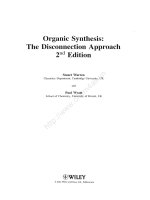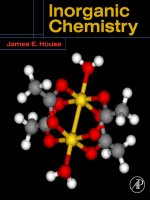Chemistry 2nd edition by julia burdge
Bạn đang xem bản rút gọn của tài liệu. Xem và tải ngay bản đầy đủ của tài liệu tại đây (40.13 MB, 1,121 trang )
Apago PDF Enhancer
bur75640_endpapers_front.indd 02
Periodic Table of the Elements
Main group
Main group
Period
number
1A
1
Group
number
8A
18
1
1
2
3
5
6
7
Hydrogen
1.008
2A
2
3
4
Li
Be
Lithium
6.941
11
Beryllium
9.012
12
Na Mg
2
6
Atomic number
C
Carbon
12.01
Name
3A
13
Average
atomic mass
5
6
7
8
9
Helium
4.003
10
B
C
N
O
F
Ne
Boron
10.81
13
Carbon
12.01
14
Nitrogen
14.01
15
Oxygen
16.00
16
Fluorine
19.00
17
Neon
20.18
18
An element
Transitional metals
Sodium
22.99
19
Magnesium
24.31
20
3B
3
4B
4
5B
5
6B
6
7B
7
8
8B
9
21
22
23
24
25
26
27
K
Ca
Sc
Ti
V
Cr
Mn
Fe
Potassium
39.10
37
Calcium
40.08
38
Scandium
44.96
39
Titanium
47.87
40
Iron
55.85
44
Rb
Sr
Y
Zr
Rubidium
85.47
55
Strontium
87.62
56
Yttrium
88.91
71
Zirconium
91.22
72
Vanadium Chromium Manganese
50.94
52.00
54.94
41
42
43
Nb Mo
Tc
Ru
Niobium Molybdenum Technetium Ruthenium
92.91
95.94
(98)
101.1
74
73
75
76
10
1B
11
2B
12
4A
14
5A
15
6A
16
7A
17
He
Symbol
Apago PDF Enhancer
4
Key
H
Al
Si
P
S
Cl
Ar
Aluminum
26.98
31
Silicon
28.09
32
Phosphorus
30.97
33
Sulfur
32.07
34
Chlorine
35.45
35
Argon
39.95
36
Ga
Ge
As
28
29
30
Co
Ni
Cu
Zn
Cobalt
58.93
45
Nickel
58.69
46
Copper
63.55
47
Zinc
65.41
48
Rh
Pd
Ag
Cd
In
Sn
Sb
Rhodium
102.9
77
Palladium
106.4
78
Silver
107.9
79
Cadmium
112.4
80
Indium
114.8
81
Tin
118.7
82
Antimony
121.8
83
Gallium Germanium Arsenic
69.72
72.64
74.92
49
50
51
Se
Br
Kr
Selenium
78.96
52
Bromine
79.90
53
Krypton
83.80
54
Te
I
Xe
Tellurium
127.6
84
Iodine
126.9
85
Xenon
131.3
86
Cs
Ba
Lu
Hf
Ta
W
Re
Os
Ir
Pt
Au
Hg
Tl
Pb
Bi
Po
At
Rn
Cesium
132.9
87
Barium
137.3
88
Lutetium
175.0
103
Hafnium
178.5
104
Tantalum
180.9
105
Tungsten
183.8
106
Rhenium
186.2
107
Osmium
190.2
108
Iridium
192.2
109
Platinum
195.1
110
Gold
197.0
111
Mercury
200.6
112
Thallium
204.4
113
Lead
207.2
114
Bismuth
209.0
115
Polonium
(209)
116
Astatine
(210)
117
Radon
(222)
118
Lr
Rf
Db
Sg
Bh
Mt
Ds
Rg
–
–
–
–
–
–
–
(285)
–
(284)
–
(289)
–
(288)
–
(293)
–
(294)
Fr
Ra
Francium
(223)
Radium
(226)
Metals
Lawrencium Rutherfordium Dubnium Seaborgium Bohrium
(262)
(267)
(268)
(271)
(272)
Lanthanides 6
Nonmetals
Metalloids
Actinides 7
57
58
59
La
Ce
Pr
Lanthanum
138.9
89
Cerium
140.1
90
Hs
Hassium
(270)
60
Meitnerium Darmstadtium Roentgenium
(276)
(281)
(280)
61
62
Nd Pm Sm
Praseodymium Neodymium Promethium Samarium
140.9
144.2
(145)
150.4
91
92
93
94
Ac
Th
Pa
U
Actinium
(227)
Thorium
232.0
Protactinium
231.0
Uranium
238.0
Np
63
64
65
66
67
68
Eu
Gd
Tb
Dy
Ho
Er
Europium
152.0
95
Gadolium
157.3
96
Terbium
158.9
97
Pu Am Cm Bk
Neptunium Plutonium Americium
(237)
(244)
(243)
Curium
(247)
Dysprosium Holmium
162.5
164.9
98
99
Cf
Es
Erbium
167.3
100
69
2
3
4
5
6
7
70
Tm Yb
Thulium
168.9
101
1
6
Ytterbium
173.0
102
Fm Md No
Berkelium Californium Einsteinium Fermium Mendelevium Nobelium
(247)
(251)
(252)
(257)
(258)
(259)
7
10/29/09 12:37:45 PM
List of the Elements with Their Symbols and Atomic Masses*
Element
Actinium
Aluminum
Americium
Antimony
Argon
Arsenic
Astatine
Barium
Berkelium
Beryllium
Bismuth
Bohrium
Boron
Bromine
Cadmium
Calcium
Californium
Carbon
Cerium
Cesium
Chlorine
Chromium
Cobalt
Copper
Curium
Darmstadtium
Dubnium
Dysprosium
Einsteinium
Erbium
Europium
Fermium
Fluorine
Francium
Gadolinium
Gallium
Germanium
Gold
Hafnium
Hassium
Helium
Holmium
Hydrogen
Indium
Iodine
Iridium
Iron
Krypton
Lanthanum
Lawrencium
Lead
Lithium
Lutetium
Magnesium
Manganese
Meitnerium
Symbol
Atomic
Number
Atomic
Mass †
Ac
Al
Am
Sb
Ar
As
At
Ba
Bk
Be
Bi
Bh
B
Br
Cd
Ca
Cf
C
Ce
Cs
Cl
Cr
Co
Cu
Cm
Ds
Db
Dy
Es
Er
Eu
Fm
F
Fr
Gd
Ga
Ge
Au
Hf
Hs
He
Ho
H
In
I
Ir
Fe
Kr
La
Lr
Pb
Li
Lu
Mg
Mn
Mt
89
13
95
51
18
33
85
56
97
4
83
107
5
35
48
20
98
6
58
55
17
24
27
29
96
110
105
66
99
68
63
100
9
87
64
31
32
79
72
108
2
67
1
49
53
77
26
36
57
103
82
3
71
12
25
109
(227)
26.9815386
(243)
121.760
39.948
74.92160
(210)
137.327
(247)
9.012182
208.98040
(272)
10.811
79.904
112.411
40.078
(251)
12.0107
140.116
132.9054519
35.453
51.9961
58.933195
63.546
(247)
(281)
(268)
162.500
(252)
167.259
151.964
(257)
18.9984032
(223)
157.25
69.723
72.64
196.966569
178.49
(270)
4.002602
164.93032
1.00794
114.818
126.90447
192.217
55.845
83.798
138.90547
(262)
207.2
6.941
174.967
24.3050
54.938045
(276)
Element
Mendelevium
Mercury
Molybdenum
Neodymium
Neon
Neptunium
Nickel
Niobium
Nitrogen
Nobelium
Osmium
Oxygen
Palladium
Phosphorus
Platinum
Plutonium
Polonium
Potassium
Praseodymium
Promethium
Protactinium
Radium
Radon
Rhenium
Rhodium
Roentgenium
Rubidium
Ruthenium
Rutherfordium
Samarium
Scandium
Seaborgium
Selenium
Silicon
Silver
Sodium
Strontium
Sulfur
Tantalum
Technetium
Tellurium
Terbium
Thallium
Thorium
Thulium
Tin
Titanium
Tungsten
Uranium
Vanadium
Xenon
Ytterbium
Yttrium
Zinc
Zirconium
Apago PDF Enhancer
Symbol
Atomic
Number
Atomic
Mass †
Md
Hg
Mo
Nd
Ne
Np
Ni
Nb
N
No
Os
O
Pd
P
Pt
Pu
Po
K
Pr
Pm
Pa
Ra
Rn
Re
Rh
Rg
Rb
Ru
Rf
Sm
Sc
Sg
Se
Si
Ag
Na
Sr
S
Ta
Tc
Te
Tb
Tl
Th
Tm
Sn
Ti
W
U
V
Xe
Yb
Y
Zn
Zr
101
80
42
60
10
93
28
41
7
102
76
8
46
15
78
94
84
19
59
61
91
88
86
75
45
111
37
44
104
62
21
106
34
14
47
11
38
16
73
43
52
65
81
90
69
50
22
74
92
23
54
70
39
30
40
(258)
200.59
95.94
144.242
20.1797
(237)
58.6934
92.90638
14.0067
(259)
190.23
15.9994
106.42
30.973762
195.084
(244)
(209)
39.0983
140.90765
(145)
231.03588
(226)
(222)
186.207
102.90550
(280)
85.4678
101.07
(267)
150.36
44.955912
(271)
78.96
28.0855
107.8682
22.98976928
87.62
32.065
180.94788
(98)
127.60
158.92535
204.3833
232.03806
168.93421
118.710
47.867
183.84
238.02891
50.9415
131.293
173.04
88.90585
65.409
91.224
*These atomic masses show as many significant figures as are known for each element. The atomic masses in the periodic table are shown to four significant figures, which is sufficient for
solving the problems in this book.
†Approximate values of atomic masses for radioactive elements are given in parentheses.
bur75640_endpapers_front.indd 03
10/29/09 12:37:45 PM
Second Edition
Chemistry
Julia Burdge
University of Idaho
Apago PDF Enhancer
TM
bur75640_FM.indd i
12/3/09 3:06:09 PM
TM
CHEMISTRY, SECOND EDITION
Published by McGraw-Hill, a business unit of The McGraw-Hill Companies, Inc., 1221 Avenue of the
Americas, New York, NY 10020. Copyright © 2011 by The McGraw-Hill Companies, Inc. All rights reserved.
Previous edition © 2009. No part of this publication may be reproduced or distributed in any form or by any
means, or stored in a database or retrieval system, without the prior written consent of The McGraw-Hill
Companies, Inc., including, but not limited to, in any network or other electronic storage or transmission, or
broadcast for distance learning.
Some ancillaries, including electronic and print components, may not be available to customers outside the
United States.
This book is printed on acid-free paper.
1 2 3 4 5 6 7 8 9 0 DOW/DOW 1 0 9 8 7 6 5 4 3 2 1 0
ISBN 978–0–07–337564–9
MHID 0–07–337564–0
Publisher: Ryan Blankenship
Senior Sponsoring Editor: Tamara L. Hodge
Vice-President New Product Launches: Michael Lange
Senior Developmental Editor: Shirley R. Oberbroeckling
Senior Marketing Manager: Todd L. Turner
Senior Project Manager: Gloria G. Schiesl
Lead Production Supervisor: Sandy Ludovissy
Senior Media Project Manager: Sandra M. Schnee
Senior Designer: David W. Hash
Cover/Interior Designer: Greg Nettles/Squarecrow Design
(USE) Cover Image: The chemical element bismuth as a synthetic-made crystal. The surface is an iridescent,
very thin layer of oxidation. ©Alchemist-hp
Senior Photo Research Coordinator: Lori Hancock
Photo Research: David Tietz/Editorial Image, LLC
Supplement Producer: Mary Jane Lampe
Compositor: Precision Graphics
Typeface: 10/12 Times
Printer: R. R. Donnelley
Apago PDF Enhancer
All credits appearing on page or at the end of the book are considered to be an extension of the copyright page.
Library of Congress Cataloging-in-Publication Data
Burdge, Julia R.
Chemistry / Julia Burdge. -- 2nd ed.
p. cm.
Includes index.
ISBN 978–0–07–337564–9 — ISBN 0–07–337564–0 (hard copy : alk. paper) 1. Chemistry-Textbooks. I. Title.
QD33.2.B865 2011
540--dc22
2009034024
www.mhhe.com
bur75640_FM.indd ii
12/3/09 3:06:09 PM
ABOUT THE
Author
Julia Burdge
received her Ph.D. (1994) from the University of Idaho in Moscow, Idaho. Her research and dissertation
focused on instrument development for analysis of trace sulfur
compounds in air and the statistical evaluation of data near the
detection limit.
In 1994 she accepted a position at The University of Akron
in Akron, Ohio, as an assistant professor and director of the
Introductory Chemistry program. In the year 2000, she was tenured and promoted to associate professor at The University of
Akron on the merits of her teaching, service, and research in
chemistry education. In addition to directing the general chemistry program and supervising the
teaching activities
graduApago
PDF ofEnhancer
ate students, she helped establish a future-faculty development
program and served as a mentor for graduate students and postdoctoral associates.
Julia has recently relocated back to the Northwest to be near family. She and her
children live in Pullman, Washington, home of Washington State University; and
she holds an affiliate faculty position in the Chemistry Department at the University of Idaho. She also continues to work with students in Ohio and Florida via an
online tutoring program.
Julia and her children are animal lovers and moved three horses, three cats,
and a dog with them to the Northwest. They are enjoying the changes of seasons,
long horseback rides on the Palouse, and frequent visits with family.
iii
bur75640_FM.indd iii
12/3/09 3:06:10 PM
To the people who will always matter the most: Katie, Beau, and Sam.
Apago PDF Enhancer
bur75640_FM.indd iv
12/3/09 3:06:12 PM
BRIEF
Contents
1 Chemistry: The Central Science 2
2 Atoms, Molecules, and Ions 34
3 Stoichiometry: Ratios of Combination 76
4 Reactions in Aqueous Solutions 116
5 Thermochemistry 170
6 Quantum Theory and the Electronic Structure of Atoms 210
7 Electronic Configuration and the Periodic Table 256
8 Chemical Bonding I: Basic Concepts 296
9 Chemical Bonding II: Molecular Geometry and Bonding Theories 338
10 Organic Chemistry 386
11 Gases 440
12 Apago
Intermolecular
Forces Enhancer
and the Physical Properties of Liquids and Solids
13 Physical Properties of Solutions 538
14 Chemical Kinetics 578
15 Chemical Equilibrium 628
16 Acids and Bases 672
17 Acid-Base Equilibria and Solubility Equilibria 726
18 Entropy, Free Energy, and Equilibrium 776
19 Electrochemistry 816
20 Nuclear Chemistry 858
21 Environmental Chemistry 892
22 Coordination Chemistry 920
23 Metallurgy and the Chemistry of Metals 944
24 Nonmetallic Elements and Their Compounds 968
25 Modern Materials 998
Appendix 1
Appendix 2
Appendix 3
492
Mathematical Operations A-1
Thermodynamic Data at 1 atm and 25°C
Solubility Product Constants at 25°C
A-6
A-12
v
bur75640_FM.indd v
12/3/09 3:06:13 PM
Contents
A Visual Approach Integrating Art and Media
List of Applications
Preface
xxii
xxiii
360° Development Process
Acknowledgments
xxviii
xxxi
Enhanced Support for Faculty & Students
1
1.1
1.3
The Study of Chemistry 4
•Apago
Chemistry You
MayEnhancer
Already Know 4 • The Scientific Method 5
1.6
7
11
• Derived Units: Volume and Density
The Properties of Matter 14
• Physical Properties 14
Why Are Units So Important?
1.5
5
Classification of Matter 6
• States of Matter 6 • Elements 6 • Compounds 7 • Mixtures
Scientific Measurement 8
• SI Base Units 9 • Mass 10 • Temperature 10
Fahrenheit Temperature Scale
1.4
xxxii
CHEMISTRY: THE CENTRAL SCIENCE 2
What Do Molecules Look Like?
1.2
xx
12
14
• Chemical Properties 15 • Extensive and Intensive Properties 15
Uncertainty in Measurement 17
• Significant Figures 17 • Calculations with Measured
Numbers 18 • Accuracy and Precision 20
Using Units and Solving Problems 22
• Conversion Factors 22 • Dimensional Analysis—Tracking Units 22
How Can I Enhance My Chances of Success in Chemistry Class?
23
vi
bur75640_FM.indd vi
12/3/09 3:06:14 PM
CONTENTS
2
2.1
2.2
2.3
2.4
ATOMS, MOLECULES, AND IONS 34
The Atomic Theory 36
The Structure of the Atom 39
• Discovery of the Electron 39 • Radioactivity 40 • The Proton
and the Nucleus 41 • Nuclear Model of the Atom 42
• The Neutron 43
Atomic Number, Mass Number, and Isotopes 44
The Periodic Table 45
Distribution of Elements on Earth
47
How Are Atomic Masses Measured?
2.5
2.6
2.7
48
The Atomic Mass Scale and Average Atomic Mass 48
Molecules and Molecular Compounds 50
• Molecules 50 • Molecular Formulas 51 • Naming Molecular
Compounds 52 • Empirical Formulas 54
Ions and Ionic Compounds 58
• Atomic Ions 58 • Polyatomic Ions 59 • Formulas of Ionic
Compounds 60 • Naming Ionic Compounds 61
How Are Oxoanions and Oxoacids Named?
• Hydrates
3
3.1
3.2
3.3
3.5
3.6
3.7
62
64 • Familiar Inorganic Compounds
65
Apago PDF Enhancer
STOICHIOMETRY: RATIOS OF COMBINATION
Molecular and Formula Masses 78
Percent Composition of Compounds 79
Chemical Equations 80
• Interpreting and Writing Chemical Equations
Chemical Equations 81
The Stoichiometry of Metabolism
3.4
76
80 • Balancing
84
The Mole and Molar Masses 86
• The Mole 86 • Determining Molar Mass 88 • Interconverting
Mass, Moles, and Numbers of Particles 89 • Empirical Formula from
Percent Composition 90
Combustion Analysis 91
• Determination of Empirical Formula 91 • Determination of
Molecular Formula 92
Calculations with Balanced Chemical Equations 94
• Moles of Reactants and Products 94 • Mass of Reactants and
Products 95
Limiting Reactants 97
• Determining the Limiting Reactant 97
Limiting Reactant Problems
• Reaction Yield
98
101
How Am I Supposed to Remember All These Reactions?
bur75640_FM.indd vii
vii
104
12/3/09 3:06:17 PM
viii
CONTENTS
4
4.1
REACTIONS IN AQUEOUS SOLUTIONS
General Properties of Aqueous Solutions 118
• Electrolytes and Nonelectrolytes 118 • Strong Electrolytes and
Weak Electrolytes 118
The Invention of Gatorade
120
How Can I Tell if a Compound Is an Electrolyte?
4.2
4.3
4.4
122
Precipitation Reactions 122
• Solubility Guidelines for Ionic Compounds in
Water 122 • Molecular Equations 125 • Ionic
Equations 126 • Net Ionic Equations 126
Acid-Base Reactions 128
• Strong Acids and Bases 128 • Brønsted Acids and
Bases 129 • Acid-Base Neutralization 131
Oxidation-Reduction Reactions 133
• Oxidation Numbers 134 • Oxidation of Metals in Aqueous
Solutions 135 • Balancing Simple Redox Equations 135
How Do I Assign Oxidation Numbers?
4.5
116
137
• Other Types of Redox Reactions 140
Concentration of Solutions 142
• Molarity 142 • Dilution 144 • Serial Dilution
145
Preparing a Solution from a Solid
146
Apago
PDF Enhancer
• Solution Stoichiometry
149
How Can We Measure Solution Concentrations?
4.6
5
5.1
5.2
5.3
5.4
150
Aqueous Reactions and Chemical Analysis 154
• Gravimetric Analysis 154 • Acid-Base Titrations
155
THERMOCHEMISTRY 170
Energy and Energy Changes 172
• Forms of Energy 172 • Energy Changes in Chemical
Reactions 172 • Units of Energy 173
Introduction to Thermodynamics 176
• States and State Functions 176 • The First Law of
Thermodynamics 177 • Work and Heat 178
Enthalpy 179
• Reactions Carried Out at Constant Volume or at Constant
Pressure 179 • Enthalpy and Enthalpy Changes 181
• Thermochemical Equations 182
Calorimetry 184
• Specific Heat and Heat Capacity 184 • Constant-Pressure
Calorimetry 185
Determination of ⌬H°rxn by Constant-Pressure Calorimetry
bur75640_FM.indd viii
186
12/3/09 3:06:22 PM
CONTENTS
Heat Capacity and Hypothermia
189
Determination of Specific Heat by Constant-Pressure Calorimetry
What if the Heat Capacity of the Calorimeter Isn’t Negligible?
5.5
5.6
6
6.1
6.2
ix
190
192
• Constant-Volume Calorimetry 193
Hess’s Law 195
Standard Enthalpies of Formation 197
QUANTUM THEORY AND THE ELECTRONIC
STRUCTURE OF ATOMS 210
The Nature of Light 212
• Properties of Waves 212 • The Electromagnetic
Spectrum 213 • The Double-Slit Experiment 213
Quantum Theory 215
• Quantization of Energy 215
Laser Pointers
216
• Photons and the Photoelectric Effect 217
Where Have I Encountered the Photoelectric Effect?
6.3
Bohr’s Theory of the Hydrogen Atom 220
Apago
Enhancer
• Atomic Line Spectra 220
• The Line
Spectrum
of Hydrogen 221
Emission Spectrum of Hydrogen
Lasers
6.4
6.5
6.6
6.7
6.8
6.9
bur75640_FM.indd ix
218
224
227
Wave Properties of Matter 228
• The de Broglie Hypothesis 228 • Diffraction of Electrons 230
Quantum Mechanics 230
• The Uncertainty Principle 231 • The Schrödinger
Equation 232 • The Quantum Mechanical Description of the
Hydrogen Atom 232
Quantum Numbers 233
• Principal Quantum Number (n) 233 • Angular Momentum Quantum
Number (ᐉ) 233 • Magnetic Quantum Number (mᐉ ) 233 • Electron
Spin Quantum Number (ms ) 234
Atomic Orbitals 236
• s Orbitals 236 • p Orbitals 237 • d Orbitals and Other HigherEnergy Orbitals 237 • Energies of Orbitals 238
Electron Configuration 239
• Energies of Atomic Orbitals in Many-Electron Systems 239 • The
Pauli Exclusion Principle 240 • The Aufbau Principle 241 • Hund’s
Rule 241 • General Rules for Writing Electron Configurations 242
Electron Configurations and the Periodic Table 243
12/3/09 3:06:28 PM
x
CONTENTS
7
7.1
ELECTRON CONFIGURATION
AND THE PERIODIC TABLE 256
Development of the Periodic Table
The Chemical Elements of Life
7.2
258
259
The Modern Periodic Table 261
• Classification of Elements 261
Why Are There Two Different Sets of Numbers at the Top
of the Periodic Table?
262
7.3
7.4
• Representing Free Elements in Chemical Equations 264
Effective Nuclear Charge 264
Periodic Trends in Properties of Elements 265
• Atomic Radius 265 • Ionization Energy 267 • Electron
Affinity 269 • Metallic Character 271
What Causes the Periodic Trends in Properties?
7.5
7.6
7.7
272
Electron Configuration of Ions 273
• Ions of Main Group Elements 273 • Ions of d-Block Elements 274
Ionic Radius 275
• Comparing Ionic Radius with Atomic Radius 275 • Isoelectronic
Series 276
Periodic Trends in Chemical Properties of the Main Group Elements 278
•Apago
General Trends
in Chemical
Properties 278 • Properties of the
Enhancer
Active Metals 279 • Properties of Other Main Group Elements 281
• Comparison of Group 1A and Group 1B Elements 285
Radioactive Bone
286
• Variation in Properties of Oxides Within a Period
8
8.1
8.2
CHEMICAL BONDING I: BASIC CONCEPTS 296
Lewis Dot Symbols 298
Ionic Bonding 299
• Lattice Energy 300 • The Born-Haber Cycle
Born-Haber Cycle
8.3
8.4
8.5
8.6
8.7
8.8
bur75640_FM.indd x
286
302
304
Covalent Bonding 306
• Lewis Structures 306 • Multiple Bonds 307 • Comparison of
Ionic and Covalent Compounds 307
Electronegativity and Polarity 308
• Electronegativity 309 • Dipole Moment, Partial Charges, and
Percent Ionic Character 311
Drawing Lewis Structures 313
Lewis Structures and Formal Charge 315
Resonance 318
Exceptions to the Octet Rule 320
• Incomplete Octets 320 • Odd Numbers of Electrons 320
12/3/09 3:06:29 PM
CONTENTS
The Power of Radicals
• Expanded Octets
321
321
Which Is More Important: Formal Charge or the Octet Rule?
8.9
9
9.1
9.2
Bond Enthalpy
xi
324
325
CHEMICAL BONDING II: MOLECULAR GEOMETRY
AND BONDING THEORIES 338
Molecular Geometry 340
• The VSEPR Model 340 • Electron-Domain Geometry and
Molecular Geometry 342 • Deviation from Ideal Bond Angles 345
• Geometry of Molecules with More Than One Central Atom 345
Molecular Geometry and Polarity 347
Can More Complex Molecules Contain Polar Bonds
and Still Be Nonpolar?
348
How Are Electrons in Orbitals Represented?
9.3
9.4
9.5
350
Valence Bond Theory 350
Hybridization of Atomic Orbitals 353
• Hybridization of s and p Orbitals 354 • Hybridization of s, p, and d
Orbitals 357
Hybridization in Molecules
ContainingPDF
MultipleEnhancer
Bonds 361
Apago
Formation of Pi Bonds in Ethylene and Acetylene
9.6
9.7
Molecular Orbital Theory 368
• Bonding and Antibonding Molecular Orbitals 368 • Molecular
Orbitals 369 • Bond Order 370 • Molecular
Orbitals 370 • Molecular Orbital Diagrams 372
Bonding Theories and Descriptions of Molecules with Delocalized
Bonding 375
10 O
10.1
10.2
366
RGANIC
CHEMISTRY
Why Carbon Is Different 388
Classes of Organic Compounds
386
390
How Are Organic Compounds Named?
392
How Do We Name Molecules with More Than One Substituent?
How Do We Name Compounds with Specific Functional Groups?
10.3
10.4
Representing Organic Molecules 400
• Condensed Structural Formulas 400 • Kekulé Structures
• Skeletal Structures 401 • Resonance 403
Isomerism 406
• Constitutional Isomerism 406 • Stereoisomerism 406
Plane-Polarized Light and 3-D Movies
bur75640_FM.indd xi
397
398
401
409
12/3/09 3:06:39 PM
xii
CONTENTS
Biological Activity of Enantiomers
10.5
Organic Reactions 410
• Addition Reactions 411 • Substitution Reactions
SN1 Reactions
The Chemistry of Vision
11.1
11.2
11.3
11.4
11.5
419
ASES
Properties of Gases 442
• Characteristics of Gases 443 • Gas Pressure: Definition and
Units 443 • Calculation of Pressure 444 • Measurement of
Pressure 444
The Gas Laws 447
• Boyle’s Law: The Pressure-Volume Relationship 447 • Charles’s
and Gay-Lussac’s Law: The Temperature-Volume Relationship 449
• Avogadro’s Law: The Amount-Volume Relationship 452 • The
Combined Gas Law: The Pressure-Temperature-Amount-Volume
Relationship PDF
453 Enhancer
Apago
The Ideal Gas Equation 455
• Deriving the Ideal Gas Equation from the Empirical Gas Laws 455
• Applications of the Ideal Gas Equation 456
Reactions with Gaseous Reactants and Products 458
• Calculating the Required Volume of a Gaseous Reactant 459
• Determining the Amount of Reactant Consumed Using Change in
Pressure 460 • Predicting the Volume of a Gaseous Product 461
Gas Mixtures 462
• Dalton’s Law of Partial Pressures 462 • Mole Fractions 463
• Using Partial Pressures to Solve Problems 464
Molar Volume of a Gas
11.7
421
440
Hyperbaric Oxygen Therapy
11.6
418
Organic Polymers 420
• Addition Polymers 420 • Condensation Polymers
• Biological Polymers 422
11 G
413
414
• Other Types of Organic Reactions
10.6
410
466
468
The Kinetic Molecular Theory of Gases 470
• Application to the Gas Laws 470 • Molecular Speed 471
• Diffusion and Effusion 474
Deviation from Ideal Behavior 476
• Factors That Cause Deviation from Ideal Behavior 476 • The van der
Waals Equation 476
What’s Really the Difference Between Real Gases
and Ideal Gases?
479
bur75640_FM.indd xii
12/3/09 3:06:43 PM
CONTENTS
12 I
NTERMOLECULAR FORCES AND THE
PROPERTIES OF LIQUIDS AND SOLIDS
12.1
Intermolecular Forces 494
• Dipole-Dipole Interactions
Sickle Cell Disease
12.2
12.3
12.5
12.6
495
496
• Dispersion Forces 498 • Ion-Dipole Interactions 500
Properties of Liquids 500
• Surface Tension 500 • Viscosity 501 • Vapor Pressure 502
Crystal Structure 505
• Unit Cells 505 • Packing Spheres 506 • Closest Packing 508
510
Types of Crystals 512
• Ionic Crystals 513 • Covalent Crystals 515 • Molecular
Crystals 515 • Metallic Crystals 516
Amorphous Solids 517
Phase Changes 517
• Liquid-Vapor Phase Transition 518 • Solid-Liquid Phase
Transition 520 • Solid-Vapor Phase Transition 521
The Dangers of Phase Changes
12.7
PHYSICAL
492
494 • Hydrogen Bonding
How Do We Know the Structures of Crystals?
12.4
xiii
Phase Diagrams
522
524
Apago PDF Enhancer
13 P
13.1
13.2
HYSICAL
PROPERTIES OF SOLUTIONS
Types of Solutions 540
The Solution Process 541
Why Do Some Things Dissolve and Not Others?
Vitamin Solubility
13.3
13.4
13.5
Hemodialysis
bur75640_FM.indd xiii
542
544
Concentration Units 547
• Molality 547 • Percent by Mass 547 • Comparison of
Concentration Units 548
Factors That Affect Solubility 550
• Temperature 550 • Pressure 550
Colligative Properties 553
• Vapor-Pressure Lowering 553 • Boiling-Point Elevation 555
• Freezing-Point Depression 556 • Osmotic Pressure 557
• Electrolyte Solutions 558
Intravenous Fluids
13.6
13.7
538
560
562
Calculations Using Colligative Properties
Colloids 565
563
12/3/09 3:06:48 PM
xiv
CONTENTS
14 C
HEMICAL
14.1
14.2
14.3
14.4
14.5
KINETICS 578
Reaction Rates 580
• Average Reaction Rate 580 • Instantaneous Rate 582
• Stoichiometry and Reaction Rate 584
Dependence of Reaction Rate on Reactant Concentration 587
• The Rate Law 587 • Experimental Determination of the Rate
Law 587
Dependence of Reactant Concentration on Time 591
• First-Order Reactions 592 • Second-Order Reactions 596
Dependence of Reaction Rate on Temperature 599
• Collision Theory 599 • The Arrhenius Equation 600
Reaction Mechanisms 604
• Elementary Reactions 604 • Rate-Determining Step 605
• Experimental Support for Reaction Mechanisms 606
How Can I Tell if a Proposed Reaction Mechanism Is Plausible?
608
What if the First Step in a Mechanism Is Not the
Rate-Determining Step?
610
14.6
Catalysis 610
• Heterogeneous Catalysis 612 • Homogeneous Catalysis
• Enzymes: Biological Catalysts 613
Catalysis and Hangovers
612
615
Apago PDF Enhancer
15 C
HEMICAL
15.1
15.2
15.3
EQUILIBRIUM 628
The Concept of Equilibrium 630
The Equilibrium Constant 632
• Calculating Equilibrium Constants 633 • Magnitude of the
Equilibrium Constant 636
Equilibrium Expressions 637
• Heterogeneous Equilibria 637 • Manipulating Equilibrium
Expressions 638
What if the Equilibrium Expression Contains Only Gases?
15.4
15.5
Using Equilibrium Expressions to Solve Problems 644
• Predicting the Direction of a Reaction 644 • Calculating
Equilibrium Concentrations 645
Factors That Affect Chemical Equilibrium 650
• Addition or Removal of a Substance 650 • Changes in Volume and
Pressure 652 • Changes in Temperature 654 • Catalysis 654
Hemoglobin Production at High Altitude
Le Châtelier’s Principle
655
656
What Happens to the Units in Equilibrium Constants?
bur75640_FM.indd xiv
641
660
12/3/09 3:06:59 PM
CONTENTS
16 A
16.1
16.2
16.3
CIDS AND
BASES 672
Brønsted Acids and Bases 674
The Acid-Base Properties of Water
The pH Scale 677
675
Antacids and the pH Balance in Your Stomach
16.4
16.5
xv
680
Strong Acids and Bases 682
• Strong Acids 682 • Strong Bases 683
Weak Acids and Acid Ionization Constants 686
• The Ionization Constant, Ka 686 • Calculating pH from Ka
Using Equilibrium Tables to Solve Problems
686
688
• Percent Ionization 691 • Using pH to Determine Ka 693
16.6 Weak Bases and Base Ionization Constants 694
• The Ionization Constant, Kb 694 • Calculating pH from Kb 695
• Using pH to Determine Kb 696
16.7 Conjugate Acid-Base Pairs 697
• The Strength of a Conjugate Acid or Base 697 • The Relationship
Between Ka and Kb of a Conjugate Acid-Base Pair 698
16.8 Diprotic and Polyprotic Acids 700
16.9 Molecular Structure and Acid Strength 703
• Hydrohalic Acids 703 • Oxoacids 703 • Carboxylic Acids 705
16.10 Acid-Base Properties of Salt Solutions 706
• Basic Salt Solutions 706
• Acidic Salt
Solutions
707 • Neutral
Apago
Enhancer
Salt Solutions 709 • Salts in Which Both the Cation and the Anion
Hydrolyze 710
16.11 Acid-Base Properties of Oxides and Hydroxides 711
• Oxides of Metals and Nonmetals 711 • Basic and Amphoteric
Hydroxides 712
16.12 Lewis Acids and Bases 712
17 A
CID-BASE EQUILIBRIA
AND SOLUBILITY EQUILIBRIA
17.1
17.2
The Common Ion Effect 728
Buffer Solutions 729
• Calculating the pH of a Buffer
Buffer Solutions
726
729
732
• Preparing a Buffer Solution with a Specific pH
Maintaining the pH of Blood
17.3
bur75640_FM.indd xv
734
735
Acid-Base Titrations 737
• Strong Acid–Strong Base Titrations 737 • Weak Acid–Strong
Base Titrations 738 • Strong Acid–Weak Base Titrations 742
• Acid-Base Indicators 744
12/3/09 3:07:09 PM
xvi
CONTENTS
17.4
17.5
Solubility Equilibria 747
• Solubility Product Expression and Ksp 747 • Calculations Involving
Ksp and Solubility 749 • Predicting Precipitation Reactions 751
Factors Affecting Solubility 753
• The Common Ion Effect 753 • pH 754 • Complex Ion
Formation 758
How Do I Solve Equilibrium Problems Involving Complex
Ion Formation?
760
17.6
Separation of Ions Using Differences in Solubility 763
• Fractional Precipitation 763 • Qualitative Analysis of Metal Ions
in Solution 764
Common Ion Effect
18 E
18.1
18.2
18.3
NTROPY,
765
FREE ENERGY, AND EQUILIBRIUM
Spontaneous Processes 778
Entropy 778
• A Qualitative Description of Entropy 779 • A Quantitative
Definition of Entropy 779
Entropy Changes in a System 780
• Calculating ⌬Ssys 780 • Standard Entropy, S° 782 • Qualitatively
Predicting the Sign of ⌬S°sys 784
Apago
PDF Enhancer
Factors That Influence the Entropy of a System
18.4
18.5
18.6
18.7
LECTROCHEMISTRY
Balancing Redox Reactions
Galvanic Cells 821
816
818
Construction of a Galvanic Cell
19.3
19.4
19.5
bur75640_FM.indd xvi
786
Entropy Changes in the Universe 788
• Calculating ⌬Ssurr 789 • The Second Law of Thermodynamics 790
• The Third Law of Thermodynamics 792
Predicting Spontaneity 793
• Gibbs Free-Energy Change, ⌬G 793 • Standard Free-Energy
Changes, ⌬G° 795 • Using ⌬G and ⌬G° to Solve Problems 796
Free Energy and Chemical Equilibrium 799
• Relationship Between ⌬G and ⌬G° 799 • Relationship Between
⌬G° and K 800
Thermodynamics in Living Systems 804
19 E
19.1
19.2
776
822
Standard Reduction Potentials 824
Spontaneity of Redox Reactions Under Standard-State Conditions
Spontaneity of Redox Reactions Under Conditions Other Than
Standard State 833
• The Nernst Equation 833 • Concentration Cells 835
830
12/3/09 3:07:20 PM
CONTENTS
Biological Concentration Cells
836
How Are Very Small Solution Concentrations Measured?
19.6
19.7
19.8
20.1
20.2
20.3
20.4
20.5
UCLEAR
CHEMISTRY
20.8
21.4
21.5
21.6
21.7
21.8
bur75640_FM.indd xvii
874
Nuclear Fusion 879
Uses of Isotopes 881
• Chemical Analysis 881 • Isotopes in Medicine
Biological Effects of Radiation 882
21 E
21.3
858
Apago PDF Enhancer
Radioactivity in Tobacco
21.1
21.2
839
Nuclei and Nuclear Reactions 860
Nuclear Stability 861
• Patterns of Nuclear Stability 862 • Nuclear Binding Energy 863
Natural Radioactivity 866
• Kinetics of Radioactive Decay 868 • Dating Based on Radioactive
Decay 868
Nuclear Transmutation 871
Nuclear Fission 873
Nuclear Fission and Fusion
20.6
20.7
837
Batteries 838
• Dry Cells and Alkaline Batteries 838 • Lead Storage Batteries
• Lithium-Ion Batteries 840 • Fuel Cells 840
Electrolysis 841
• Electrolysis of Molten Sodium Chloride 841 • Electrolysis
of Water 842 • Electrolysis of an Aqueous Sodium Chloride
Solution 842 • Quantitative Applications of Electrolysis 844
Corrosion 846
20 N
xvii
NVIRONMENTAL
882
884
CHEMISTRY
892
Earth’s Atmosphere 894
Phenomena in the Outer Layers of the Atmosphere 897
• Aurora Borealis and Aurora Australis 897 • The Mystery Glow of
Space Shuttles 898
Depletion of Ozone in the Stratosphere 899
• Polar Ozone Holes 900
Volcanoes 902
The Greenhouse Effect 902
Acid Rain 907
Photochemical Smog 909
Indoor Pollution 910
• The Risk from Radon 910 • Carbon Dioxide and Carbon Monoxide
912 • Formaldehyde 912
12/3/09 3:07:34 PM
xviii
CONTENTS
22 C
OORDINATION
22.1
22.2
22.3
22.4
22.5
CHEMISTRY
920
Coordination Compounds 922
• Properties of Transition Metals 922 • Ligands 924
• Nomenclature of Coordination Compounds 926
Structure of Coordination Compounds 928
Bonding in Coordination Compounds: Crystal Field Theory 931
• Crystal Field Splitting in Octahedral Complexes 931 • Color 932
• Magnetic Properties 933 • Tetrahedral and Square-Planar
Complexes 935
Reactions of Coordination Compounds 936
Applications of Coordination Compounds 937
The Coordination Chemistry of Oxygen Transport
23 M
ETALLURGY AND THE
OF METALS 944
23.1
Occurrence of Metals
23.3
23.4
23.5
23.6
23.7
bur75640_FM.indd xviii
CHEMISTRY
946
The Importance of Molybdenum
23.2
938
947
Metallurgical Processes 947
•Apago
PreparationPDF
of the Ore
947 • Production of Metals 947
Enhancer
• The Metallurgy of Iron 948 • Steelmaking 949 • Purification
of Metals 951
Band Theory of Conductivity 952
• Conductors 952 • Semiconductors 953
Periodic Trends in Metallic Properties 954
The Alkali Metals 955
The Alkaline Earth Metals 957
• Magnesium 958 • Calcium 958
Aluminum 959
12/3/09 3:07:45 PM
CONTENTS
24 N
ONMETALLIC ELEMENTS
AND THEIR COMPOUNDS
24.1
24.2
24.3
24.4
24.5
24.6
ODERN
25.1
MATERIALS
Polymers 1000
• Addition Polymers
25.3
25.4
25.5
25.6
25.7
990
998
1000 • Condensation Polymers
Electrically Conducting Polymers
25.2
968
General Properties of Nonmetals 970
Hydrogen 970
• Binary Hydrides 971 • Isotopes of Hydrogen 972
• Hydrogenation 973 • The Hydrogen Economy 973
Carbon 974
Nitrogen and Phosphorus 975
• Nitrogen 975 • Phosphorus 978
Oxygen and Sulfur 980
• Oxygen 980 • Sulfur 982
The Halogens 985
• Preparation and General Properties of the Halogens 987
• Compounds of the Halogens 989 • Uses of the Halogens
25 M
xix
1005
1007
Apago PDF Enhancer
Ceramics and Composite Materials 1009
• Ceramics 1009 • Composite Materials 1010
Liquid Crystals 1011
Biomedical Materials 1013
• Dental Implants 1014 • Soft Tissue Materials 1014
• Artificial Joints 1015
Nanotechnology 1016
• Graphite, Buckyballs, and Nanotubes 1016
Semiconductors 1018
Superconductors 1020
Appendixes
1 Mathematical Operations A-1
2 Thermodynamic Data at 1 atm and 25°C A-6
3 Solubility Product Constants at 25°C A-12
Glossary G-1
Answers to Odd-Numbered Problems
Credits
Index
bur75640_FM.indd xix
AP-1
C-1
I-1
12/3/09 3:08:00 PM
A Visual Approach
Integrating Art and Media
Sample Problems:
Strong problem-solving skills are essential for student
success. I provide a consistent, step-wise approach in
every worked example.
Sample Problem 2.7
Write the empirical formulas for the following molecules: (a) glucose (C6H12O6), a substance known
as blood sugar; (b) adenine (C5H5N5), also known as vitamin B4; and (c) nitrous oxide (N2O), a gas
that is used as an anesthetic (“laughing gas”) and as an aerosol propellant for whipped cream.
Strategy To write the empirical formula, the subscripts in the molecular formula must be reduced to
the smallest possible whole numbers (without altering the relative numbers of atoms).
Setup The molecular formulas in parts (a) and (b) each contain subscripts that are divisible by
common numbers. Therefore, we will be able to express the formulas with smaller whole numbers
than those in the molecular formulas. In part (c), the molecule has only one O atom, so it is
impossible to simplify this formula further.
Solution (a) Dividing each of the subscripts in the molecular formula for glucose by 6, we obtain
the empirical formula, CH2O. If we had divided the subscripts by 2 or 3, we would have obtained
the formulas C3H6O3 and C2H4O2, respectively. Although the ratio of carbon to hydrogen to oxygen
atoms in each of these formulas is correct (1:2:1), neither is the simplest formula because the
subscripts are not in the smallest possible whole-number ratio.
(b) Dividing each subscript in the molecular formula of adenine by 5, we get the empirical formula, CHN.
(c) Because the subscripts in the formula for nitrous oxide are already the smallest possible whole
numbers, its empirical formula is the same as its molecular formula, N2O.
Strategy: Read the problem carefully and identify an
approach that can be used to answer the question.
Think About It Make sure
that the ratio in each empirical
formula is the same as that in the
corresponding molecular formula
and that the subscripts are the
smallest possible whole numbers.
In part (a), for example, the
ratio of C:H:O in the molecular
formula is 6:12:6, which is equal
to 1:2:1, the ratio expressed in the
empirical formula.
Practice Problem A Write empirical formulas for the following molecules: (a) caffeine (C8H10N4O2),
a stimulant found in tea and coffee, (b) butane (C4H10), which is used in cigarette lighters, and
(c) glycine (C2H5NO2), an amino acid.
Setup: Gather the necessary information, including data,
constants, and equations.
Solution: Following the appropriate strategy, use the
information to solve the problem.
Think About It: Evaluate the result to make sure that it
makes sense. Does it have the right sign, units, and/or
magnitude?
Practice Problem A: This is a problem similar to the
sample problem that students can solve using the same
strategy.
Caffeine
Butane
Glycine
Practice Problem B For which of the following molecular formulas is the formula shown in parentheses
the correct empirical formula? (a) C12H22O11 (C12H22O11), (b) C8H12O4 (C4H6O2), (c) H2O2 (H2O)?
Practice Problem B: This problem is about the same
topic, but is sufficiently different from the Sample
Problem that it cannot be solved using the same strategy.
These problems encourage students to develop
problem-solving strategies on their own—helping them
to build the confidence necessary to tackle unfamiliar
problems.
Apago PDF Enhancer
Visualizing Chemistry
Figure 17.8
11.74 Consider the three containers shown, all of which have the same
volume and are at the same temperature. (a) Which container has
the smallest mole fraction of gas A (red)? (b) Which container has
the highest partial pressure of gas B (green)? (c) Which container
has the highest total pressure?
(i)
(ii)
VC 17.5 Which of the following would cause precipitation of the
largest amount of AgCl when 0.1 mole is dissolved in the
saturated solution shown in Figure 17.8?
a) NaCl
b) CsCl
c) Both would cause precipitation of the same amount.
(iii)
Problems: I provide lots of end-of-chapter problems,
grouped by section, graduated in difficulty, and paired so
that students have answers to every other problem. Many
of the end-of-chapter problems are integrated into the
online homework, including the conceptual question sets
that correspond to the Visualizing Chemistry figures.
xx
bur75640_FM.indd xx
12/3/09 3:08:54 PM
Figure 17.8
Common Ion Effect
After filtering off the solid AgCl, we
dissolve enough NaCl to make the
concentration of Cl
1.0 M.
We prepare a saturated solution by
adding AgCl to water and stirring.
In the resulting saturated solution, the
concentrations of Ag and Cl are equal,
and the product of their concentrations
is equal to Ksp.
[Ag ][Cl ] 1.6 10 10
Therefore, the concentrations are
[Ag ] 1.3 10 5 M
and [Cl ] 1.3 10 5 M
Neither AgCl nor a saturated solution of
AgCl is purple. The color has been used
in this illustration to clarify the process.
Because the concentration of Cl is now larger, the product
of Ag and Cl concentrations is no longer equal to Ksp.
[Ag ][Cl ]
(1.3
10
5
M)(1.0 M)
1.6
10
10
In any solution saturated with AgCl at 25°C, the product of
[Ag ] and [Cl ] must equal the Ksp of AgCl.
Therefore, AgCl will precipitate until the product
of ion concentrations is again 1.6 10 10.
Note that this causes nearly all the dissolved AgCl
to precipitate. With a Cl concentration of 1.0 M, the
highest possible concentration of Ag is 1.6 10 10 M.
[Ag ](1.0 M)
therefore, [Ag ]
1.6
1.6
10
10
10
10
M
START
What's the point?
The amount of AgCl precipitated is
exaggerated for emphasis. The actual amount
of AgCl would be extremely small.
756
When two salts contain the same ion, the ion they both contain is
called the “common ion.” The solubility of a slightly soluble salt
such as AgCl can be decreased by the addition of a soluble salt
with a common ion. In this example, AgCl is precipitated by
adding NaCl. AgCl could also be precipitated by adding a soluble
salt containing the Ag ion, such as AgNO3.
757
Art:
I have worked closely with artists to develop engaging two-page
“Visualizing Chemistry” figures. These pieces are step-wise
illustrations of processes and common laboratory procedures, and are
designed to make sure students get the right take-away message.
Visualizing Chemistry figures have also been made into animations,
which I narrate myself. They can be shown in the classroom or viewed
by students in the electronic homework. Each figure is accompanied by
a series of conceptual end-of-chapter problems, which are also
integrated into the online homework.
Apago PDF Enhancer
What's the point?
My book has been developed and written with the student in
mind. Information is presented clearly in a digestible format with
engaging artwork, designed to bring concepts to life; concept art
is used consistently to foster better comprehension; and
pedagogical features foster the kinds of student activities that
lead to competence and confidence in problem-solving .
xxi
bur75640_FM.indd xxi
12/3/09 3:10:06 PM
LIST OF
Applications
What Happens to the Units on Equilibrium Constants?
FAQ Boxes
What Do Molecules Look Like?
Why Are Units So Important?
How Do I Solve Equilibrium Problems Involving Complex Ion
Formation?
760
5
14
How Can I Enhance My Chances of Success in Chemistry
Class?
23
How Are Atomic Masses Measured?
48
How Are Very Small Solution Concentrations
Measured?
837
Bringing Chemistry to Life
How Are Oxoanions and Oxoacids Named?
62
Fahrenheit Temperature Scale
How Am I Supposed to Remember All These
Reactions?
104
How Can I Tell if a Compound Is an Electrolyte?
How Do I Assign Oxidation Numbers?
660
122
11
Distribution of Elements on Earth
47
The Stoichiometry of Metabolism
84
The Invention of Gatorade
136
How Can We Measure Solution Concentrations?
150
120
Heat Capacity and Hypothermia
189
Pointers
218
Apago PDF Laser
Enhancer
Lasers
227
What if the Heat Capacity of the Calorimeter Isn’t
Negligible?
192
Where Have I Encountered the Photoelectric Effect?
218
The Chemical Elements of Life
259
Why Are There Two Different Sets of Numbers at the Top of
the Periodic Table?
262
Radioactive Bone
What Causes the Periodic Trends in Properties?
Plane-Polarized Light and 3-D Movies
272
286
The Power of Radicals
321
Which Is More Important: Formal Charge or the Octet
Rule?
324
Biological Activity of Enantiomers
Can More Complex Molecules Contain Polar Bonds and Still
Be Nonpolar?
348
The Chemistry of Vision
How Are Electrons in Orbitals Represented?
How Are Organic Compounds Named?
350
SN1 Reactions
419
Hyperbaric Oxygen Therapy
466
496
How Do We Name Molecules with More Than One
Substituent?
397
The Dangers of Phase Changes
Vitamin Solubility
544
How Do We Name Compounds with Specific Functional
Groups?
398
Intravenous Fluids
560
What’s Really the Difference Between Real Gases and Ideal
Gases?
479
Catalysis and Hangovers
How Do We Know the Structures of Crystals?
Why do Some Things Dissolve and Not Others?
510
542
How Can I Tell if a Proposed Reaction Mechanism Is
Plausible?
608
Hemodialysis
410
414
Sickle Cell Disease
392
409
522
562
615
Hemoglobin Production at High Altitude
655
Antacids and the pH Balance in Your Stomach
Maintaining the pH of Blood
680
735
Biological Concentration Cells
What if the First Step in a Mechanism Is Not the RateDetermining Step?
610
Radioactivity in Tobacco
What if the Equilibrium Expression Contains Only
Gases?
641
The Importance of Molybdenum
836
884
The Coordination Chemistry of Oxygen Transport
Electrically Conducting Polymers
938
947
1007
xxii
bur75640_FM.indd xxii
12/3/09 3:10:21 PM









